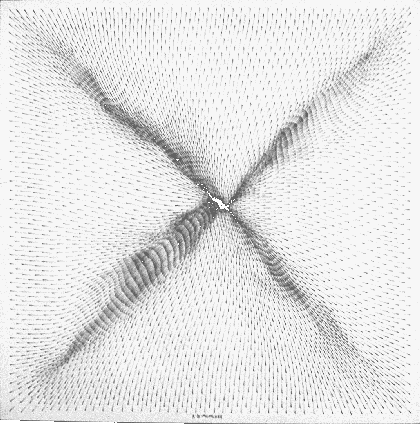
Page from my Diary, 9 October 1972 (37 x 37 cm)
FORM IS THE LANGUAGE OF TIMEDrawings by Robert Horvitz |
Since 1970, all of my drawings have been made with
just one kind of mark.
I put the pen on the paper and flick it.
The
split-second acceleration of the penpoint attenuates the flow of ink
so
that the mark tapers, then breaks into tiny skips, and then disappears
completely.
This leaves a straight comet-shaped track about 1-2 cm
long.
No two marks are exactly the same, but their diversity is strictly limited.
Most of my drawings contain thousands of marks.

Page from my Diary, 9 October 1972
(37 x 37 cm)
My mark happens to be left/right symmetrical,
even
though
the beginning of the mark is very different from the end:
it is clearly
an action, asymmetrical in time.
Bilateral symmetry makes it possible to use this mark to
evoke symmetries from the paper.
For example, by bisecting the angle
of a corner, or bisecting the length of an edge.
Bisection is the most
basic way to generate symmetry.
Repeating a mark creates
another kind of symmetry - based on translation rather than reflection.
Translation and reflection are like transitive and intransitive verbs in the
grammar of drawing.
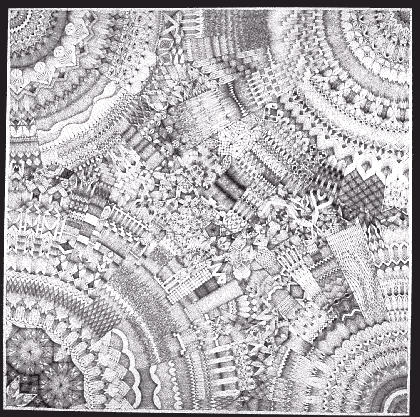
Personal Domain of Freedom & Ecstasy #2,
7-11 June 1973 (51 x 51 cm)
As soon as I reduced my technique to making one kind of
mark,
I wanted the drawings to show the actual order in which the marks were
made.
Yet even drawings with strict sequencing show that ink stops time.
Marks made earlier co-exist on paper with the marks made later.
Sequences always fade to coincidence, history foreshortens into structure,
process becomes place.
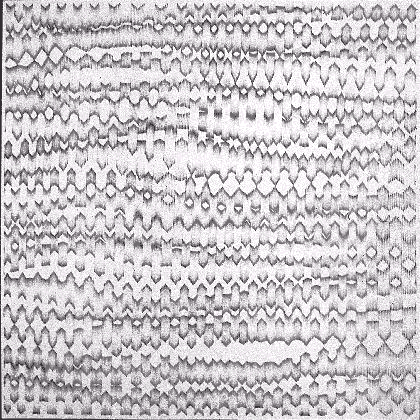
Page from my diary, 15-17 January
1997
(37 x 37 cm)
Time's foreshortening seems not so much a problem, though,
as a magic trick,
an illusion hiding a space where I can move
freely.
I
quit insisting on visible chronologies and started exploring how time settles
into space.
Because the fact is, except for the symmetry of a mark's
shape,
or symmetry derived from the shape of the paper,
symmetry in
drawing is always an optical illusion.
Configurations appear
symmetrical
because the sequence of acts which produced them has collapsed into
simultaneity.
True symmetry would require the making of a mark to be followed by the
unmaking of the mark.
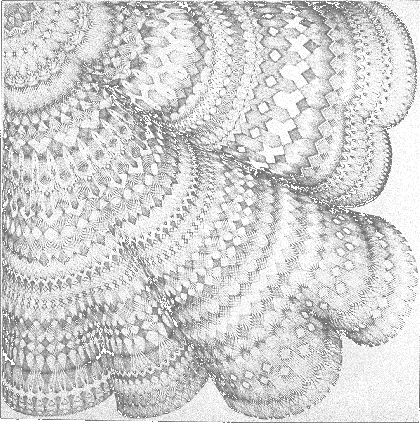
Page from my Diary,
30 March - 7 April 1999 (37 x 37 cm)
Reading Teilhard de Chardin's The Phenomenon of Man in
1971
made me want to learn more about the fundamentals of time and space,
matter and energy.
So I stumbled almost accidentally into the
literature of
particle physics.
There I found that time-order ambiguities were a key to
Einstein's relativity.
The laws of Newton, Maxwell, Dirac and
Heisenberg all
treat past and future as interchangable.
Symmetry and its breaking
seemed to be
a major theme of physics,
somehow defining the properties of the
universe.
"...I was immersed in Pythagorean fantasy, reading up on natural
proportions such as Planck's constant, p, Hubble's constant,
the gravitational constant. I read an essay on Planck's constant
written by Erwin Schrodinger that was so brilliant and vivid in
its description of the geometry of elemental matter that I am still
immersed in the subject.
"But since the quantum concepts of physics came into my head
months after I had reduced my drawing to combinations of a single
element, I can't say I do what I do because science says reality
does it that way..." (Journal entry, 27 December 1971)
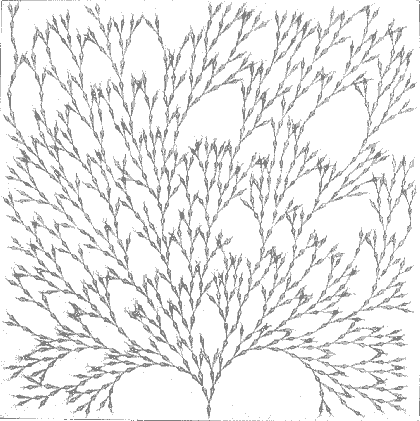
Page from my diary, 1 August 1978
(37 x 37 cm)
Nonetheless, I did start thinking of my mark as a quantum
act
caught in a web of symmetries and asymmetries,
and I continue to
draw
inspiration from modern physics and mathematics.
Robert Horvitz
Slavikova 11
120 00 Prague 2
Czech Republic
email: horvitz@mbox.vol.cz
|
Robert Horvitz was born in the United States in 1947. He studied art at Yale University (BA, 1969). He has had solo exhibitions of drawings at the Institute of Contemporary Art (Boston, Massachusetts, 1972), the Akron Art Institute (Akron, Ohio, 1972 and 1979), the Nexus Gallery (Atlanta, Georgia, 1985) and a large retrospective at Exhibition Hall Manes (Prague, 1999). Two more solo shows are planned for later this year. Horvitz has taught art-related courses at Yale, the Massachusetts Institute of Technology (School of Architecture), Massachusetts College of Art, and the Rhode Island School of Design. He currently teaches at the University of New York/Prague. |